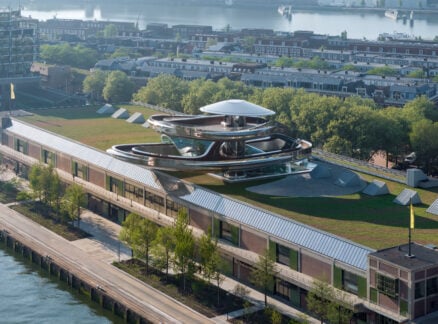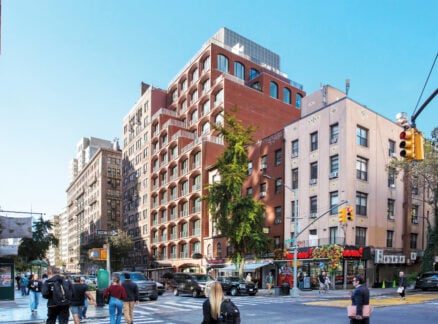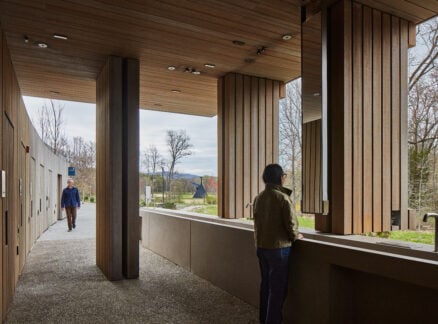
April 4, 2018
Interrobang Revives and Restores a British Art Deco Masterpiece
The British architecture and engineering firm has transformed London’s 1933 Hoover Building into a 66-unit residential complex, returning it to its former glory in the process.

“Five miles out of London on the Western Avenue
Must have been a wonder when it was brand new
Talkin’ ‘bout the splendor of the Hoover factory
I know that you’d agree if you had seen it too”
While these Elvis Costello lyrics are hardly groundbreaking (the melody didn’t do them much favor, either), the English rocker’s song, Hoover Factory, is notable for praising the aesthetics of a factory rather than blue collar factory-work itself. While Costello’s number, released in 1980, hasn’t made a comeback, the factory in question has just been returned to its former glory.
The 85-year-old Hoover Building, once all but abandoned, has been restored courtesy of London-based Interrobang architects and engineers with developer IDM Properties. Where 3,000 people used to work, residents in 66 luxury residences (a mix of studios, 1-, 2-, and 3-bedroom units) will now live, with the first move-ins scheduled before the month is up.
“We asked ourselves, ‘How do you occupy [the building] with another use, that doesn’t become immediately apparent?’” says Matthew Dalziel, an associate at Interrobang. “We didn’t want to lose that experience one knows and loves, of driving past the Hoover building.”
The factory, built for The Hoover Company of vacuum fame, was designed by Wallis, Gilbert, and Partners and opened in 1933. It boasts a wide spanning neo-Egyptian facade that looks onto Western Avenue, now more commonly known as the A40, a noisy and notoriously busy road that heads into West London.

To mitigate the sound of eight lanes of traffic and improve thermal performance, the previous tenant (who had converted the factory to offices and a supermarket) had lined the building with second layer of glazing. However, the new windows didn’t align with the original openings underneath. “This gave away that it was a building within a building…that a ’90s office lay behind,” explains Dalziel.
Interrobang aligned the new glazing with the existing frames, painting the new frames, mullions, and blinds dark gray instead of white. Given their slightly recessed depth (ten inches), the new windows disappear behind the old facade. “This means everything inside is blanked out, like theater blacking, making the original building pop out at you,” says Dalziel.
The biggest task that faced the architects, however, was fitting 66 units into the building. The factory’s Streamline Egyptian splendor doesn’t go far beyond the front door, meaning Interrobang could add extra floors between the existing slabs without touching the historically-protected facade. Using a wooden frame, the firm installed a mezzanine level which now fills the original double-height ground floor. Timber trusses, concealed within walls on the second and third floors, support other new units. Lastly, a new lightweight hipped roof that houses 12 loft apartments remains out-of-sight when viewed from the ground outside. Through further structural sleight of hand, the new roof—made from prefabricated timber A-frames and roof cassettes that rest on pre-existing columns—eschewed the need to structurally reinforce the rest of the building.

In the lobby, terrazzo flooring and a grand staircase have been restored, along with wrought iron banisters that run throughout the building. The firm even used forensic color testing to ensure it used original hues.
Despite its pomp, the Hoover factory had been collecting dust for 13 years, highlighting the tricky nature of repurposing large-scale buildings of architectural significance. In fact, the factory could have easily followed the fate of Wallis, Gilbert, and Partners’ other neo-Egyptian Art Deco factory nearby, which was built for Firestone, closed in 1979, and demolished in 1980, two days before it would’ve received landmark listing protections. Luckily, as a result, heritage groups sprung into action. By October 1980, 150 interwar buildings, including the Hoover Factory, had been listed. Around that time, Costello, maybe the only artist to recognize Egyptian architectural inflection, saw the song Clubland (with its B-side Hoover Factory) climb to number 60 in the U.K. charts upon release.
Even if Costello’s song won’t reach the top 100 again, the Hoover factory will soon have new life. If you can’t enter the building and don’t want to waste time stuck in traffic, this Art Deco gem’s rebirth is best enjoyed travelling by car at night. The facade is brilliantly illuminated to show off all its exuberant features. And as for what should be playing from the stereo, the song of choice should be obvious.
You may also enjoy “BBC TV Studio, Home to ‘Monty Python,’ ‘Fawlty Towers,’ Converted to 4,000 Luxury Apartments and More.”





















